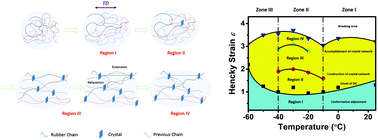In situ characterization of strain-induced crystallization of natural rubber by synchrotron radiation wide-angle X-ray diffraction: construction of a crystal network at low temperatures†
Abstract
Strain-induced crystallization (SIC) of natural rubber (NR) at descending temperatures as low as −60 °C is systematically investigated by in situ synchrotron radiation wide-angle X-ray diffraction (SR-WAXD) measurement. The detailed structural evolution of NR during SIC is studied in the strain–temperature space, where up to four regions are defined depending on the SR-WAXD results. In region I, the molecular chains begin to be oriented under tensile loading. The onset of crystallization happens in the very beginning of region II, and the NR crystal acts as a new physical cross-linking point to form a crystal network, namely the series model. The further increment of crystallinity (> ca. 8%) leads to the transition of the crystal network from the series model to the parallel model in region III. The crystal network is finally accomplished in region IV, where the crystallinity remains almost constant. Interestingly, regions III and IV exist only in the intermediate-temperature zone II (−40 °C to −10 °C), which are missing in zones I (−10 °C to 25 °C) and III (−60 °C to −40 °C). This suggests that sufficient crystallinity (χII–III > ca. 8%) is required to form the parallel model. The new crystal network provides a deep understanding of SIC of NR considering the microscopic features, i.e. oriented amorphous component, the onset of crystallization and crystallinity evolution and its correlation with the macroscopic stress–strain curve.



 Please wait while we load your content...
Please wait while we load your content...